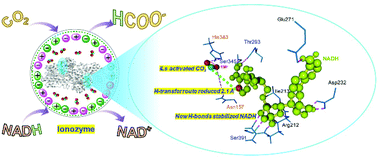Ionozyme: ionic liquids as solvent and stabilizer for efficient bioactivation of CO2†
Abstract
The efficient bioactivation of CO2 provides an alternative new strategy for producing high value chemicals and fuels. Normally, in vitro activation of CO2 can be achieved by using formate dehydrogenase (FDH). However, the CO2 solubility and the activity of commercial FDHCb remain a tough challenge for the efficient bioactivation of CO2. Here, we report a new “ionozyme” strategy created by using ionic liquids (ILs) as a solvent and enzyme stabilizer, resulting in a 142.3-fold increase in CO2 conversion over FDHCb. The ionozyme (FDHPa-[CH][Pro]-[TMGH][PhO]) was first developed by combing a discovered novel FDHPa with an efficient synergistic ionic microenvironment. The remarkable performance of this ionozyme is attributed to forming key intermediates [CH][ProCOO] and [TMGH][PhOCOO], stabilizing the enzyme structure with increased solvation structure, and shortening the distance (3.9 Å) between NADH and CO2 to favor the hydride transfer by facilitating their relative orientation and forming new hydrogen bonds at the active sites. This bioactivation of CO2 by this specific ionozyme represents ideal starting points for the sustainable carbon cycle.

- This article is part of the themed collection: 2021 Green Chemistry Hot Articles


 Please wait while we load your content...
Please wait while we load your content...